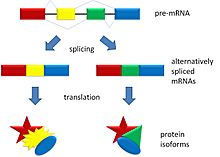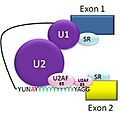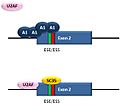Alternative splicing facts for kids

Alternative splicing allows DNA to code for more than one protein. It varies the exon make-up of the messenger RNA.
In alternative splicing the exons of the pre-messenger RNA produced by transcription are reconnected in different ways during RNA splicing.
This produces different mature messenger RNAs from the same gene. They get translated into different proteins. Thus, a single gene may code for multiple proteins.
Alternative splicing is normal in eukaryotes. It greatly increases the diversity of proteins that can be encoded by the genome. In humans, ~95% of multiexonic genes are alternatively spliced.
There are various kinds of alternative splicing: the most common is exon skipping. An exon may be included in mRNAs under some conditions or in particular tissues, and omitted from the mRNA in others. There are splicing activators that promote the use of a particular splice site, and splicing repressors that reduce the use of a particular site. New types of alternative splicing are being found.
Abnormal variations in splicing occur in disease. Many human genetic disorders come from splicing variants. Abnormal splicing variants may also contribute to the development of cancer. Non-working splicing products are usually dealt with by post-transcriptional quality control. That is, they are chopped up by enzymes.
Alternative splicing (the re-combination of different exons) is a major source of genetic diversity in eukaryotes. One particular Drosophila gene (DSCAM) can be alternatively spliced into 38,000 different mRNA.
Images for kids
-
Alternative splicing produces three protein isoforms. Protein A includes all of the exons, whereas Proteins B and C result from exon skipping.
See also
 In Spanish: Empalme alternativo para niños
In Spanish: Empalme alternativo para niños








